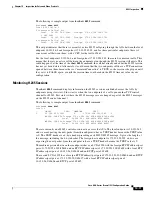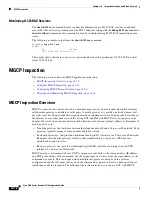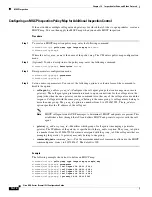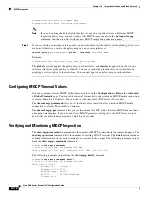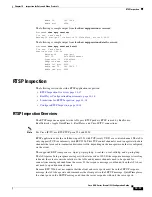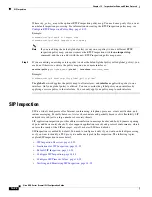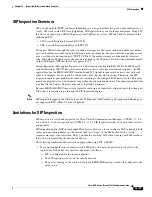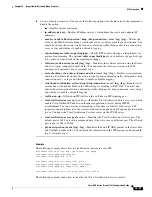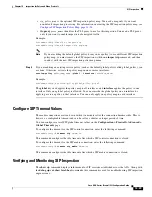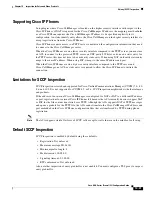
14-25
Cisco ASA Series Firewall CLI Configuration Guide
Chapter 14 Inspection for Voice and Video Protocols
SIP Inspection
Before You Begin
Some traffic matching options use regular expressions for matching purposes. If you intend to use one
of those techniques, first create the regular expression or regular expression class map.
Procedure
Step 1
(Optional) Create a SIP inspection class map by performing the following steps.
A class map groups multiple traffic matches.You can alternatively identify
match
commands directly in
the policy map. The difference between creating a class map and defining the traffic match directly in
the inspection policy map is that the class map lets you create more complex match criteria, and you can
reuse class maps.
To specify traffic that should not match the class map, use the
match not
command. For example, if the
match not
command specifies the string “example.com,” then any traffic that includes “example.com”
does not match the class map.
For the traffic that you identify in this class map, you specify actions to take on the traffic in the
inspection policy map.
If you want to perform different actions for each
match
command, you should identify the traffic directly
in the policy map.
a.
Create the class map by entering the following command:
hostname(config)#
class-map type
inspect sip
[
match-all
|
match-any
]
class_map_name
hostname(config-cmap)#
Where
the class_map_name
is the name of the class map. The
match-all
keyword is the default, and
specifies that traffic must match all criteria to match the class map. The match-any keyword
specifies that the traffic matches the class map if it matches at least one
match
statement. The CLI
enters class-map configuration mode, where you can enter one or more
match
commands.
b.
(Optional) To add a description to the class map, enter the following command:
hostname(config-cmap)#
description
string
Where
string
is the description of the class map (up to 200 characters).
c.
Specify the traffic on which you want to perform actions using one of the following
match
commands. If you use a
match not
command, then any traffic that does not match the criterion in
the
match not
command has the action applied.
•
match
[
not
]
called-party regex
{
regex_name
|
class
class_name
}—Matches the called party,
as specified in the To header, against the specified regular expression or regular expression
class.
•
match
[
not
]
calling-party regex
{
regex_name
|
class
class_name
}—Matches the calling party,
as specified in the From header, against the specified regular expression or regular expression
class.
•
match
[
not
]
content length gt
bytes
—Matches messages where the content length in the SIP
header is greater than the specified number of bytes, from 0 to 65536.
•
match
[
not
]
content type
{
sdp
|
regex
{
regex_name
|
class
class_name
}—Matches the content
type as SDP or against the specified regular expression or regular expression class.
•
match
[
not
]
im-subscriber regex
{
regex_name
|
class
class_name
}—Matches the SIP IM
subscriber against the specified regular expression or regular expression class.
•
match
[
not
]
message-path regex
{
regex_name
|
class
class_name
}—Matches the SIP via
header against the specified regular expression or regular expression class.
Summary of Contents for ASA 5508-X
Page 11: ...P A R T 1 Access Control ...
Page 12: ......
Page 157: ...P A R T 2 Network Address Translation ...
Page 158: ......
Page 233: ...P A R T 3 Service Policies and Application Inspection ...
Page 234: ......
Page 379: ...P A R T 4 Connection Management and Threat Detection ...
Page 380: ......

